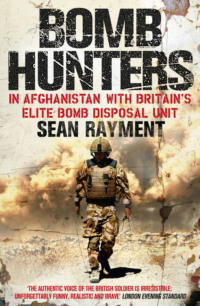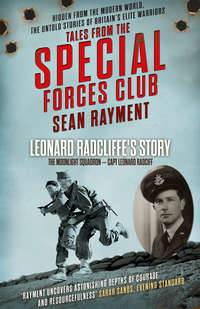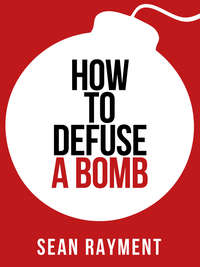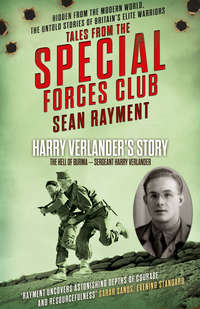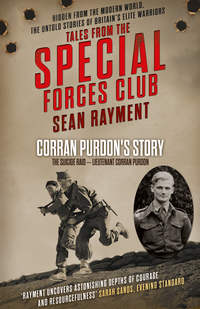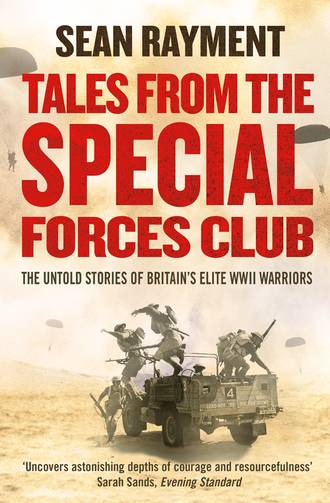
Полная версия
Tales from the Special Forces Club
‘Bill was very ill. I don’t think any of us thought that he was going to make it, and at one point his grave was dug; that was how close he was to death. Bill spent all his time back in the MO’s truck, and the only thing which saved him was one of the new sulphur drugs. When he was cured, he went back to the LRDG but joined one of the New Zealand patrols as a signalman and stayed with them until the end of the desert campaign.
‘Captain David Lloyd Owen, the skipper of the Yeomanry, or Y Patrol, asked me if I would like to join his patrol and I jumped at it. I became a Lewis gunner initially, but some time later the patrol navigator was selected for a commission and I began training to take his place, first as assistant navigator and then doing the full role.
‘The main role of the LRDG was doing reconnaissance and “road watch”. This involved monitoring the movements of enemy forces along the main coast road in the Benghazi area. The patrol would position itself a couple of miles from the road, camouflage up, and each evening two men would walk up to the road to a hide, rather like a birdwatching hide. They would sit there for 24 hours, making a note of everything which went past. All of this intelligence would be passed back up the chain of command to the staff officers at General Headquarters to help formulate future offensives or withdrawals.
‘Apart from the enemy, one of the other great challenges of desert warfare is coping with the heat. In the summer the temperature often reached 120°F, while dropping to below zero at night. In the winter the weather could be miserable.
‘The stripped-down vehicles kept the soldiers cool on long patrols and the men quickly acclimatised to the heat. To cope with the heat we dressed accordingly and often wore sandals – which were given to us as a special issue – instead of boots. We found that the standard issue baggy shorts were much more comfortable than long trousers, too. We were issued with these Arab headdresses which we folded into a triangle and fixed with a ring of black material known as an egal. These were meant to protect our heads but I didn’t often wear one. I personally wore a cap comforter, a woollen thing which folded up into a cap. In the winter we wore full-length sheepskin coats, woolly hats, gloves and a thick jumper to keep out the cold.
‘We’d have a variety of devices to keep ourselves warm. We would take an Italian water bottle, which was quite a capacious thing made of aluminium, fill it with water and break up a bar of chocolate into it and hang it over the exhaust and within five miles we would have a hot drink. We each had a blanket roll, no beds or sleeping bags, and we would just unroll that by the wheel of the truck. We had a rum ration every evening and some lime powder. We would mix the rum and lime with water and when we woke up we would have a nice cold drink.’
The LRDG continued with their reconnaissance operations and before long Jimmy was established as Lloyd Owen’s personal navigator. It was at this stage that rumours began to surface about a large raid involving many different units – a major departure from the type of operations usually conducted by the LRDG.
It was widely believed that Field Marshal Erwin Rommel, known as the Desert Fox, and the commander of the Axis forces in North Africa, was planning a major offensive eastwards along the coast.
One of those working on the British plan was Colonel John ‘Shan’ Hackett, who would later command the 4th Parachute Brigade at Arnhem. In essence the plan would involve members of the LRDG, the SAS, Army Commandos, Royal Marines, Popski’s Private Army,‡ the RAF and the Royal Navy launching simultaneous attacks on the Libyan coastal city of Benghazi, where a large German garrison was based, Tobruk and Barce. Once these attacks had succeeded, the Sudanese Defence Force were to attack the Jalo Oasis. If everything went to plan, Rommel’s bold aggressive thrust to move east and destroy the 8th Army would lie in tatters.
But the plan quickly became over-ambitious and too complex. In simple terms, the plan was as follows: at Tobruk, Lieutenant-Colonel John Haselden,§ a highly decorated British officer, would lead a force composed of around 80 commandos, engineers and Royal Artillery gunners, who were to capture the harbour and facilitate the landing of reinforcements by sea. Those reinforcements would then destroy underground fuel stores, release British POWs being held in the area and attack two airfields close to the city.
Meanwhile the SAS, supported by two Rhodesian LRDG patrols, would attack the harbour at Benghazi, destroying shipping and fuel storage tanks.
The raid on the Barce airfield was to be conducted by the LRDG, who would also be supported by the commander of Popski’s Private Army, Lieutenant-Colonel Vladimir Peniakoff.
Four days later the Sudanese Defence Force were to secure Jalo, which would then be used by David Stirling for further desert operations. D-Day for the operation was 13 September 1942.
But with so many staff officers now involved in the operation, security became a major concern. Gossip and rumours were rife in both Alexandria and Cairo, with some senior officers chatting openly about the operation over a gin and tonic in many of the bars and clubs which played host to the Allies.
In David Lloyd Owen’s excellent memoir Providence Their Guide: The Long Range Desert Group, 1940–45, the author recalls his fears for the success of the operation because of the loose talk in the bars and cafés of Cairo.
‘Even before I had first been put in the know by John Haselden in Cairo I had heard rumours; and I had heard these through gossip at parties and in the bars of Cairo. I was very suspicious that security had been blown, and I told John Haselden of my fears when he arrived in Kufra the day before we were due to set off on the 800-mile journey to Tobruk.
‘There was little that John, or indeed myself, could do at that stage except to tell all those involved with us what was planned, in order to scotch all the rumours that were current. This did not help, however, to allay our fears that we would be walking into a trap.’
Despite the bond of trust which existed amongst and between members of the LRDG, Lloyd Owen refused to brief his troops on the operation until just a few hours before D-Day. The soldiers knew that something was afoot, but they also understood that surprise, and therefore secrecy, was vital if any behind-the-lines raid was to succeed. On 24 August the five vehicles and 20 men of Y Patrol left the Fayoum, 80 miles south of Cairo, for the first stage of the operation.
‘We set out from the LRDG base at Fayoum and drove down to Asyut. We spent one night in a house which belonged to John Haselden. It was very comfortable, with a swimming pool and nice gardens. At that time we didn’t really have any idea what the target was. We had heard the rumours, of course, and we knew something big was going to come off.
‘At Asyut we met up with Haselden’s force of commandos. There were about 80 of them in seven 3-ton trucks, together with some sappers and gunners. We didn’t know it at the time, but the ruse was that the commandos were supposed to be POWs and their German guards were actually German Jews from the Special Interrogation Group (SIG). A great deal of planning had gone into making this work. The guards had proper German uniforms, faked papers, faked letters from girlfriends, and of course they spoke perfect German. Although the 3-tonners were British, they were painted with Afrika Korps markings. It was common practice at the time for both sides to use captured vehicles, so their presence should not have aroused suspicion.
‘After we picked up the commandos, we travelled across the desert to Kufra. It was a four-day trip, made slower by seven lumbering 3-tonners which kept getting stuck in soft sand. By now we had covered around 1,000 miles when the desert heat was at its most fierce.
‘We didn’t know any detail, we didn’t know where we were going. We just knew that something was coming off. We were to escort the commandos to the scene of the action, and that was to be done via Kufra.’
On 31 August Y Patrol and the commandos arrived at Kufra, the staging post for the combined operation, and the next six days were spent preparing for the mission. It was a relaxed yet busy period, and the troops quickly made themselves at home amongst the date palms which dotted the oasis.
As days passed, more men from other units began to arrive at Kufra, and rumours again began to surface. Haselden flew into the base on 5 September, and Lloyd Owen convinced him that the time had come to brief everyone on the mission.
Jimmy continued: ‘We were eventually briefed the night before we left Kufra, and it was a great relief. D-Day was 13 September and everyone was very relieved that it didn’t fall on a Friday.
‘John Haselden briefed us on the operation on the night before we were due to leave Kufra. He unfurled a map and explained in detail what we were going to do. Everyone was very enthusiastic, there were no morbid thoughts, and we were all utterly convinced that the mission would be a total success.
‘Our job was to deliver the commandos to Tobruk, secure the perimeter, then, at a given signal, move into the town and attack a radar station and then finally free some British POWs who were being held there. The idea was that the commandos would run amok, destroying as much as possible before being evacuated by sea.
‘The thing I was most concerned with was making sure that I had the right maps. I would be navigating, so that was obviously on my mind. It was another six-day trip but although it was routine for the LRDG it would have been pretty tough for the commandos, who weren’t use to these long-range desert patrols.
‘At one stage we had to find our way between the oasis of Jalo, which was occupied at the time, and the Sand Sea. So we had to steer a very accurate passage through a narrow corridor and we couldn’t show any light and had to be careful about noise.’
One of the main risks was being spotted by enemy aircraft and so some of the movement was conducted at night. The pace was slow and comfortable and the convoy arrived at Hatiet Etla on 10 September, where the small force took cover amongst the scrub and sand dunes. Y Patrol was now just 90 miles from Tobruk, and D-Day loomed ever closer.
‘You get to a stage where you just want to get on with things, and that was the case at Hatiet Etla. There was a lot of scrub in the area, which was ideal for camouflaging our vehicles, and we remained there for the next two days, completing our final preparations. The plan was rehearsed several times so that everyone knew what part to play and also what to do if things went wrong.
‘Everyone was making sure that their personal equipment was in perfect working order and that the vehicles were sound. It was that sort of thing, resting as much as possible and passing the time.’
The convoy moved off again on the morning of 13 September to an area called Ed Duda, 20 miles from the Tobruk perimeter. It was at this location that Haselden and his commandos went their separate way on what was ultimately to become a fatal mission. As the four 3-ton lorries containing the commandos departed, the men of the LRDG waved silently, many of them wondering what fate awaited their comrades.
As Haselden’s party moved off to the north, a small party of German troops were spotted and the two groups passed within two miles of each other. Rather than hide and risk being reported to German intelligence, Lloyd Owen decided to bluff it out and ordered Y Patrol to spread out and advance, hoping that the Germans would assume they were friendly forces given that they were 300 miles behind enemy lines.
‘We got right in amongst them before we opened fire. I think right up until that point they must have thought we were friendlies. We never gave them a chance, we just kept firing until all but one was dead and we captured him. It was kill or be killed. If we had let them go they would have reported us and we would probably have been bombed. That was the first time I had seen a dead body. It was the sort of thing you expect. If you are going to be involved in a war there are going to be dead bodies, but it didn’t affect me at all. I didn’t feel any sympathy, I didn’t feel any fear. I was detached. I had grown used to war.’
The captured prisoner then broke the news that everyone feared, revealing that he was one of many reinforcements who had been sent into Tobruk in recent days to prepare for a possible attack.
‘After that attack, we destroyed the enemy vehicles and moved off again briefly. Then we stopped, had a meal and waited to hear from the commandos. The idea was that Haselden would get in touch and brief us on the enemy situation so that we would be able to deal with any Germans on our route in. I think after about an hour we began to realise that something must have gone wrong. The radio operator kept trying to make contact but there was nothing. So after several hours we moved off down to the escarpment at Sidi Rezegh. Movement down the escarpment was painfully slow because it was so steep and covered in boulders.
‘We eventually reached the perimeter fence well after midnight and everyone knew the plan was already seriously behind schedule. By now we could hear the sounds of battle in the distance. The RAF had flown over some hours earlier dropping their massive pay-loads.
‘Lloyd Owen came over to me and said, “Patch, where do you think we are?” I pointed to the map and said “Here.” I was absolutely certain that we were within 100 yards of the perimeter. The message then came around that we were going to stay put until dawn and then go in and destroy our first target, which was the radar station. So the vehicles moved into cover and we waited.
‘I didn’t know it at the time, but the radio operator had spent most of the night trying to raise Haselden while we either rested or mounted sentries. By the morning the battle was still raging, but without any radio contact it was impossible to know what was going on.
‘Just before dawn Lloyd Owen called us all together and explained that he had been unable to contact Haselden or any of his commandos and that consequently we had no idea what was going on. The only option was to race back to the escarpment, set up the radio antennae and try and make contact with HQ to try and get an update on the situation.
‘Within 10 minutes we were on the move, racing past these huge German tented camps. Titch Cave, a belligerent character, who was the skipper’s gunner, wanted to open fire. He was manning a .50 calibre Vickers and he wanted to shoot up the camps as we drove past, but the Skipper said we just had to push on. It was quite an extraordinary sight. We could see all these German soldiers queuing for breakfast and we were racing past them. We could see them looking at us but no one tried to stop us.’
Y Patrol moved up and over the escarpment and continued for another 20 miles before halting and trying to reach HQ again, but it would take another seven hours before they eventually made contact and were given the dreadful news that the Tobruk element of the plan had been an abject failure. The large coastal guns which the commandos had been tasked with destroying had been moved, and the Royal Navy had suffered heavy casualties, losing two destroyers and a cruiser, and had also failed to land reinforcements. Y Patrol was ordered not to return to Tobruk but to make instead for Hatiet Etla and await further orders.
‘We moved off just as it was beginning to get dark. I had managed to get a few hours’ sleep but we were all pretty tired. But the worst feeling was knowing that the mission had been a failure. We still didn’t know what had happened, only that the raid had failed and casualties were heavy. It was a huge anti-climax and we all felt very dejected. When we arrived at Hatiet we had to wait a bit and then we were told to move to a place called Landing Ground 125, an emergency airstrip near Barce, about 80 miles from our location, near the Kalansho Sand Sea. The landing ground was to be used as a rallying point and we were told that there would be a lot of injured soldiers and men who had been separated from their units heading there.
‘I plotted a route and off we went. We left in the afternoon and arrived at LG125 when it was dark. LG125 was south of Barce, which was the scene of another raid which was exclusively LRDG, executed by New Zealanders and guardsmen, and that was quite a success. The LRDG destroyed a lot of aircraft, but they again ran into some resistance and had taken some casualties, and the theory was that the injured might have made their way to LG125.
‘We eventually found them later that night. There were about eight of them under a tarpaulin, being looked after by our medical officer, Richard Lawson, who had behaved admirably throughout the whole of the Barce raid. He had been dashing around treating men under fire and was awarded the Military Cross. Popski was also amongst the wounded – he had lost his little finger. We helped in whatever way we could, gave them cigarettes, water, food and some rum. A message was also sent back to our base requesting a transport aircraft to come and pick up the wounded. The next day an RAF Bombay arrived, flown by an officer called Flight Lieutenant John Coles, a professional airman, who later became an Air Marshal. It was a masterpiece of navigation on his part. He had flown across the desert, which was flat and featureless, but he managed to find this little strip with practically nothing on it except a few oil drums to mark it out as an airfield. We didn’t know precisely when he was coming and we didn’t have any pre-arranged signals. He had a couple of men with him, but by the time he landed this old Bombay had used up all of its petrol. But it was carrying petrol for its return journey in four-gallon jerrycans. So we all helped in the refuelling and the injured were loaded on board, and by the next morning they had all arrived safely in Cairo.’
After the RAF Bombay had departed, Y Patrol were ordered to remain at LG125 for the next 24 hours to await and assist those who had become separated from their respective units during the raid. By the time Y Patrol was ready to depart, on 20 September, they had been joined by another 60 stragglers.
‘We arrived back at Kufra on 25 September. I think we were all relieved to be back but also very angry about what had happened, because there was a very strong view that the failure could have been avoided if people had kept their mouths shut. It really was a case that careless talk costs lives.
‘By the time we got back to Kufra, other soldiers who had taken part in the other raids were already there and we soon began to swap stories. The general consensus was that we had all been let down by staff officers in Cairo, because of their loose talk and bad planning.’
A few days after arriving at Kufra, one of the most extraordinary events of Jimmy’s war took place during a German bombing raid. The Germans knew that Kufra was a British base and would occasionally attack. On this occasion, eight Junker 88s attacked the airfield where the RAF Bombays were located.
‘The bombing run took the Jerry aircraft right over the top of the date palms beneath which we [Y Patrol], the New Zealanders, G Patrol and the SAS were billeted. Our guns were still mounted on our vehicles and as they passed over us we all let rip. There were dozens of machine-guns firing up at them and we managed to shoot down six out of the eight aircraft. It so happened I was on some sort of errand on foot in another part of the oasis so I didn’t take part, I just heard this huge racket. Jerry made the mistake of assuming that we would be in the great fort built by the Italians, whereas that was the last thing we would think of doing, because it was such an obvious target. The 88s were easy targets because they were so low, just a couple of hundred feet, and so were difficult to miss – especially if you have several machine-guns all firing at the same time.
‘As they came over they were met by this barrage of machine-gun fire. I was desperate to get back and have a go, but things like that are over in a couple of minutes and I was too late. It was unheard of to shoot down six aircraft.
‘During the raid Lloyd Owen was wounded by a 20mm cannon shell which caught his back and arm. It was a very serious wound and I know that a lot of us thought he might not survive. But he eventually got back to Cairo and made a pretty good recovery.’
Over the following weeks the full catastrophe of the earlier mission began to unfold. It soon emerged that John Haselden had been killed leading an assault to capture the coastal guns. The commandos did achieve some initial success during the early stages of the operation but were overwhelmed by the size of the enemy force. Because the guns were not captured, the Royal Navy were unable to land the reinforcements who were supposed to bolster Haselden’s commandos, and the mission was doomed.
The SAS also faced fierce resistance at Benghazi and the Sudanese Defence Force did not fare well at Jalo either. Only the raid on the airfield at Barce could be described as a success, so overall, as an attempt to delay Rommel’s build-up for the offensive at El Alamein, the operation was a failure.
For Y Patrol the war seemed to be trundling along as they settled into a routine of road watch and long-range reconnaissance. Then planning began for a raid on the oasis at Hon, which at the time was occupied by the Italians.
‘We set off from Kufra and it was planned to be a two- or three-day trip. The journey was very routine and went without a hitch. The idea was to see what sort of garrison the Germans had there, beat it up, see how the enemy would respond and get as much intelligence as we could so we could plan future operations. It was like a fighting reconnaissance patrol. The skipper, who by that time was a chap called Captain Spicer, went forward in his jeep to check things out at the oasis, while we took cover amongst a rocky outcrop.
‘They went in and had a good look around, but they must have been spotted because some time later an Italian Caproni 309 Ghibli, a bomber, came over. We all opened fire at the aircraft and it veered away and that was the last we saw of it. But it was replaced by a number of CR42 biplanes. By now the Chevrolets had scattered and moved into defensive positions beneath a hill, with the sun behind us, so anyone attacking us would have to dive into the sun.
‘Then these damn planes started attacking us, but we opened up with these wonderful twin Vickers and that kept them away. When a plane is diving straight at you, it is pretty terrifying. I remember thinking, “I don’t want to be killed because of the effect it would have on my parents.” That was all I was thinking about; I wasn’t thinking about myself as such, just the grief it would cause my parents. It was a 50–50 chance that I would be killed. The bullets were coming in very close, and there was a sort of wop, wop sound as they hit the ground around me. As far as I was concerned, the pilot was trying to nail me. The sound of a round hitting the ground close to you is pretty terrifying, I can tell you, but the planes were put off by our shooting and they were unable to keep a direct course straight down to us. It was happening over and over, waves of planes attacking us. It was a very frightening incident indeed and that was about the closest I came to being killed, it was a pretty narrow squeak. If they had managed to get a bead on us for any length of time it would have been curtains, but to hit us they had to fly straight, and the pilots knew they were vulnerable when flying straight. The idea was to force them to twist and turn, which we did, and eventually they gave up and we hot-footed it back to Kufra.’
* * *
By May 1943 the whole of the North African coast was under Allied control. The LRDG had developed into a force of great renown. The challenge was to decide how the organisation should be used in the future and in what theatre.
One evening in late May, as the members of Y Patrol relaxed, the news came through that the LRDG were to be retrained for missions in Albania, Greece, Yugoslavia and Northern Italy.




